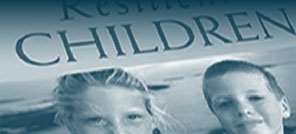We are very happy that you like sharing articles from the site. To send more articles to your friends please copy and paste the page address into a separate email.Thank You.
Printer-Friendly Version | Email Article
In my previous two columns I focused on the ways in which the inborn temperament of children impacts on both their development and the manner in which adults respond to them. I reviewed the work of two of the most influential researchers of temperament, psychiatrists Stella Chess and Alexander Thomas. They and their colleagues identified nine characteristics of temperament in infants, and based upon these nine characteristics they labeled three kinds of infants, the “easy” child; the “slow-to-warm-up,” cautious, or shy child; and the “difficult” child. In my March column I described guidelines for interacting with the “slow-to-warm-up” child. My original intention was for this months column to discuss principles for relating to the temperamentally difficult youngster and then I would address a new content area next month. However, when I finished writing this months article it was much longer than I anticipated so that I decided it would be best to divide the topic of temperamentally difficult children it into two sections, one this month, the second to appear in May.
To begin, I should note that a number of individuals have taken issue with the label “difficult,” believing that it carries with it a negative connotation that children do not deserve. As alternatives they have offered more positive descriptions such as “challenging” or “spirited.” Certainly, the label we place on children influences the ways in which we understand and respond to their behaviors. To view children as challenging or spirited has an optimistic and hopeful flavor, which may help parents and other caregivers respond to these youngsters in a more caring, empathic, effective manner. As the reader may recall from my earlier columns about “stress hardiness,” I tend to use the word “challenge” in my work since one of the features of individuals who are less stressed is that they view difficult situations as challenges to master rather than as stressors to avoid.
My use of the word “difficult” is based on the label first used by Chess and Thomas and also by psychiatrist Stanley Turecki in his book “The Difficult Child.” The reality is that the behaviors of these youngsters do present difficulties to those with whom they interact, but the adults who will have most success in reaching and teaching these youngsters possess a more optimistic outlook of their future.
What are these difficult, challenging, frustrating behaviors? In my February column I described several of these features, which are also captured in Tureckis book “The Difficult Child,” in Chess and Thomas’s “Know Your Child,” and in “The Explosive Child” by my friend and colleague psychologist Ross Greene. The reader may also wish to review Mary Sheedy Kurcinka’s excellent book “Raising Your Spirited Child,” which places the temperamental features of the so-called “difficult” child in a more favorable light and emphasizes how we can accommodate to the unique make-up of spirited youngsters.
Temperamentally difficult children demonstrate intense reactions and overreactions so that even seemingly small upsets may result in rage, tantrums, and meltdowns. Many of these children experience changes in routine or new situations with a great deal of anxiety, almost as if they were being asked to climb Mt. Everest without the appropriate equipment or training. Given their rigid, inflexible style, difficult children become fearful and angry when confronted with unplanned or spontaneous activities. I have worked with some difficult children who could not fall asleep until they knew the next day’s schedule and/or in the morning asked their parents repeatedly what was to transpire during the day. Not surprisingly, transitions or moving from one activity to the next present major hurdles to these youngsters. A very common problem I hear from teachers about their students with difficult temperaments is that these students find transitions (e.g., going from one subject matter to another or one activity to another or one room to another) problematic; equally stressful for many of these students are less structured activities such as recess or lunch.
The style of many temperamentally difficult children works against the establishment of warm, satisfying interpersonal relationships in several ways. First, they frequently appear to be insatiable and difficult to please. In my workshops I often comment, “You can spend 59 minutes of your time with a difficult child and they will tell you about the one minute you did not spend.” When I say this, many parents of temperamentally difficult youngsters nod with exasperated looks. One parent said, “Dr. Brooks, just last night I devoted all of my time to my eight-year-old son. I received a phone call from my sister and told her I was playing with my son and would call her back later. You’d think my son would be grateful that I didn’t get into a discussion with my sister. His only comment was, ’How come you answered the phone?’” Their insatiability is also apparent when they do not get what they want such as a toy or game or being allowed to stay up to watch a television show in such instances they will tell their parents how mean the parents are.
Second, and related to the first point, is that because of their inflexible nature difficult youngsters lack the fine art of negotiation and compromise. Possessing an “all or none” mindset, they perceive any compromise as “giving in” or as one 12-year-old girl told me, “It’s like you’re surrendering and why should I surrender when I’m right?” They are frequently seen as “bossy” by their peers, demanding that you do what they want. Since winning is everything, they may gloat when victorious at a game but accuse the other person of cheating when they themselves lose. Obviously, none of these qualities will endear them to others. I recall a nine-year-old boy I saw in therapy who loved to play the card game “War” in my office. When he won he gleefully said, “I killed you.” When he was losing he accused me of not shuffling the cards correctly. This behavior was similar to his interactions with his classmates.
Third, it is not unusual for difficult youngsters to wear a tense look, rarely smiling. The truth is that most adults as well as peers find it easier to relate to children whose eyes twinkle, who appear relaxed and at ease, and who constantly flash a warm, inviting smile. One mother brought in family photos to show me and said that she could not find one in which her son was smiling. She added, “He just never seems happy.” All too often a negative cycle is triggered in which the child seems unhappy, the parents are unable to soothe the child and begin to either back away or become intrusive, and the child becomes even more tense and angry at the parents actions.
Fourth, a number of difficult children are hypersensitive to sound or touch. They complain that people are yelling at them or that the labels in their shirts are like sandpaper pushing against their body. They frequently tense up when an adult touches them. They give the impression that they don’t want you in their lives. In fact many of these children would welcome your presence, but unfortunately their style and hypersensitivities hide any semblance of a welcoming sign. In essence, they push away the very people who could provide them with support.
As one reads these descriptions of temperamentally difficult children, one might forecast a gloomy future for them. However, while these children will face greater obstacles than their peers with easy temperaments in achieving high self-esteem and success in many areas of their lives including in their friendships and in school, there are actions that parents, teachers, and other adults can take to help temperamentally difficult children live more satisfying lives. The first two points were discussed in my column about “slow-to-warm-up” children, but since they apply to difficult children as well, I will review them briefly in this column and then introduce the notion of a “proactive” parent or other caregiver.
First, parents and other adults must become as knowledgeable as possible about temperamental differences in children. If we are not aware of these differences or minimize their importance we will continue to hold the same expectations for all children, which is not the fair thing to do. As I continually emphasize, if children are different from birth then fairness should not be interpreted as treating all children the same but rather treating them differently based on their unique temperament and needs.
Also, if we are not aware of these differences we may assume things about our children’s behavior that are not true. For example, a mother of a temperamentally difficult five-year-old girl said to me, “I think my daughter has a personal vendetta against me.” Unfortunately, this mother had little information about the different temperaments in children and viewed her daughters excessive demands and anger as a deliberate attempt to get back at her for something she may have done.
Second, we must learn to accept our children for who they are and not what we want them to be. This is easy to say, but not to achieve. Whether we realize it or not, as parents we have expectations for our children even prior to their birth, but most children are not able to meet many of these expectations. When they do not, negative feelings are aroused as illustrated by the mother I quoted in my February column who said of her five-year-old temperamentally difficult son, “My son made me feel like the most inadequate mother in the world from the moment I first held him.” He was a child who did not like to be held or comforted.
Accepting children for who they are is not meant to suggest that we refrain from helping our children modify those characteristics of their temperament that are causing them and the adults in their lives distress but rather that our assistance must be done with empathy, compassion, and caring. Caregivers must recognize that we as the adults must have the insight and courage to take the initial steps to accommodate to the childs style rather than expect the child to adapt to what we want. Parents and other adults must strive to provide what is called in the child development literature a “goodness-of-fit” between our expectations and the child’s inborn temperament. In essence, if the temperamentally difficult child is to have an opportunity to lead a happier life filled with satisfying relationships then it is the adults who must at first accommodate within reason to the child’s style rather than expecting the child to accommodate to theirs.
Third, we must understand how best to arrive at this “goodness-of-fit?” I believe to do so we must adopt a “crisis prevention” or proactive position rather than a “crisis intervention” or reactive approach. Without realizing it many parents tend to be reactive, that is, they react from moment to moment to their childrens behavior and as a result feel harried, hassled, and even helpless. It is especially important to become a “proactive” parent when we have temperamentally difficult children who can so quickly perceive the world as unfair and who can react with such intensity to various situations. A proactive parent asks, “What can I do in advance to create an environment that will minimize my child’s difficulties and help my child learn more adaptive ways of handling problems?” My column in May will be devoted to articulating some of the main steps necessary to develop and implement an effective proactive plan both at home and school.



